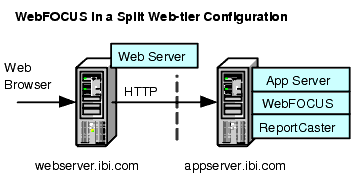WebFOCUS installs a pair of web applications into the drive:\ibi\WebFOCUS82\webapps directory,
which are designed to serve static content from the file system
to the browser:
- approot.war.
Serves content from the drive:\ibi\apps directory.
- ibi_html.war.
Serves content from the drive:\ibi\WebFOCUS82\ibi_html directory.
Deploy one or both of these applications to address the following
split web-tier and stand-alone application server configurations:
Each application includes a deployment descriptor
(webconfig.xml) that is used to locate the directory containing
its configuration file. The context parameter IBI_Configuration_Directory in
webconfig.xml is updated during installation to point to drive:/ibi/WebFOCUS82/config,
which contains the configuration file approotConfig.xml. The configuration
file is shared by both content server applications even though its
name suggests it would be used by only one. The configuration file
is used to maintain MIME mappings, the physical path of the directories
being served, and the logging level.
The applications also include a Log4J property
file (log4j.xml), which contains the path to the log file used by
each application. The installation updates each log4j.xml file with
the path to its own log file, drive:/ibi/WebFOCUS82/logs/wfapproot.log
and drive:/ibi/WebFOCUS82/logs/wfibihtml.log, respectively.
The content server applications roll the
log files over daily by appending the date to the log file and creating
a new one (for example, wfibihtml.log.2016-01-01). You can increase the
log level by editing drive:/ibi/WebFOCUS82/config/approotConfig.xml
and changing the log level setting to DEBUG, INFO, WARN, ERROR,
or FATAL, where DEBUG is the most verbose.
There are special considerations for
using the content server option in a clustered web-tier environment.
